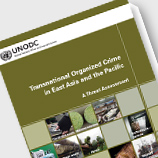 16 April 2013 - UNODC launched today an assessment of the transnational organized crime threat in the East Asia and the Pacific (EAP) region. This vast region has experienced rapid economic and social changes during the past few decades which have created considerable regulation challenges for public authorities. The report takes a look at the manner in which criminal enterprises have developed alongside legitimate commerce in recent years, creating contraband markets valued at approximately US$ 90 billion.
16 April 2013 - UNODC launched today an assessment of the transnational organized crime threat in the East Asia and the Pacific (EAP) region. This vast region has experienced rapid economic and social changes during the past few decades which have created considerable regulation challenges for public authorities. The report takes a look at the manner in which criminal enterprises have developed alongside legitimate commerce in recent years, creating contraband markets valued at approximately US$ 90 billion.
The 12 selected contraband markets covered in the report are organized under four headings, namely: people (human trafficking and the smuggling of migrants); narcotic drugs (heroin and methamphetamine); environment (wildlife, wood-based products, e-waste and ozone-depleting substances); and goods (counterfeit goods and fraudulent medicines).
Drug trafficking accounts for an estimated one third of the value of transnational organized crime (TOC) flows studied in this report. The findings show that an estimated 65 metric tons of heroin worth US$16.3 billion flowed within the region in 2011, of which two-thirds were produced in the Shan State of Myanmar. A significant proportion of the US$15 billion worth of methamphetamine within the region is manufactured in the region itself, although there are notable amounts entering from West Africa and the Middle East.
Approximately one-third of TOC flows valued at US$24.4 billion are related to counterfeit goods and another US$5 billion to fraudulent medicines. High levels of demand for counterfeit products in many different parts of the world, coupled with the region's growing economy and ability to meet this demand has been a driver for the growth of counterfeiting.
The report also examines several types of environmental crime including extractive industries such as the illegal harvesting and trafficking of wood-based products worth US$17 billion, wildlife valued at US$2.5 billion, the dumping of e-waste estimated at US$3.75 billion, and the trafficking in ozone-depleting substances of US$ 0.0677 billion. Environmental crimes are profitable forms of TOC in East Asia and the Pacific, as many countries in the region are rich in natural resources but lack the capacity to enforce laws to protect them.
This report is a first look at major TOC flows relevant to the region and aims to contribute to policy and programme development. It is vital to integrate national responses into international strategies in order to effectively combat these issues. The United Nations Convention against Transnational Organized Crime and its Protocols, as well as the Convention against Corruption, provide useful platforms for the establishment of a normative framework to guide efforts towards capacity-building and the strengthening of regional partnerships.